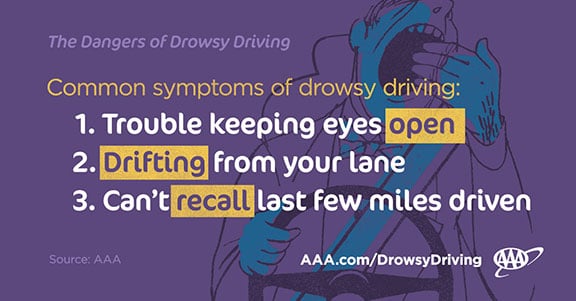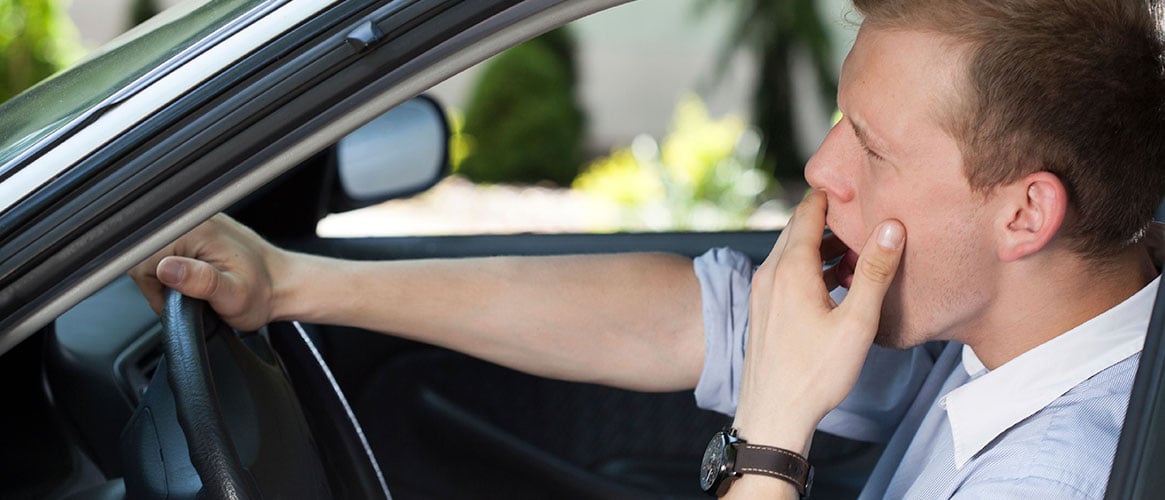Drowsy driving can be deadly. A key finding in a study lead by the AAA Foundation for Traffic Safety found that 16.5 percent (one-in-six) of fatal crashes involved a tired or drowsy driver. When someone gets behind the wheel without enough sleep, they can become confused, use poor judgment, and put themself at greater risk of getting into an accident. A drowsy driver scans the road less, nods off at the wheel, and has slower reaction times.
What your employees need to know about the dangers of drowsy driving
Lack of sleep may cause a condition known as microsleep—a brief moment of sleep that can last for up to 30 seconds. When driving at 65 miles an hour, a driver that nods off for three seconds will travel approximately 95 yards (nearly the length of a football field). In those few seconds, the driver could run into the car in front of them, they could swerve and hit a wall or drive into a ditch.
Below are symptoms a drowsy driver may experience:
- Daydreaming, disconnected thoughts

Driving while drowsy increases your chance of causing a traffic accident. - Yawning, can’t keep head up
- Frequent blinking, heavy eyelids, rubbing eyes
- No memory of the last few miles
- Difficulty focusing on the road
- Drifting from lane to lane, tailgating, or grazing the shoulder of the road or rumble strip
- Missing exits and street signs (a major telltale sign of fatigue and drowsiness)
What your employees need to do to avoid driving drowsy
Get a full eight hours of sleep. One common misconception is that as long as an individual gets some sleep, they will not suffer from fatigue. The NSF has found that most people who don’t get the recommended hours of sleep are twice as likely to drive drowsy than those who do.
In addition to getting enough sleep, below are some extra steps to take:
- Schedule driving breaks. Plan to stop every 100 miles or two hours to take a stretch break and freshen up. Drivers feeling drowsy at this point might consider taking a 10 to 20 minute power nap during the stop.
- Caffeinate. Caffeine can increase alertness in the short term, but it’s not a substitute for sleep.
- Eat lightly. More frequent, smaller meals are less likely to cause drowsiness than one large one.
- Drink fluids. The body can become drowsy when a driver is dehydrated.
What to cover at your safety meeting on drowsy driving prevention
Remind your employees to prepare for the drive ahead and allow plenty of time to arrive at the destination. Below are topics to discuss with your employees during your next safety meeting:
- Review the symptoms of drowsy driving.
- Review what your employees need to do to avoid driving drowsy.
Have them take additional steps to ensure they arrive safely:
- Develop a schedule for long road trips and plan stops along the route.
- Take the Federal Motor Carrier Safety Foundation (FMSCA)'s “Drowsy Driving Quiz” with your employees. This quiz will test your knowledge about drowsy driving and make everyone more aware of the facts surrounding drowsy driving.
- Discuss with them the importance of driving defensively and avoiding distractions.
The safety of your employees is one of your top priorities, including when they are on the road. Make sure they know the steps to take if they start feeling sleepy.
Always remind your employees: stay awake, drive alert, and arrive alive!

